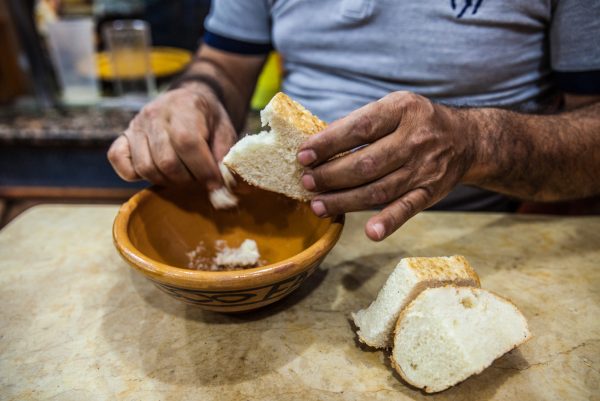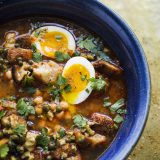It's late. Or rather, it's early, that predawn twilight when club kids haven't made it home and the day's earliest workers have just left it. In Tunisia, that's the time for a steaming bowl of lablabi—a rich, but simple soup.
As I make my way into Restaurant Fattoumm on Tunis' waterfront, a throng of partiers and laborers clamors at the counter. Bushels of stale baguettes and flaming burners licking pots of chickpeas line the ochre back wall.

The space is so tight in the tiny wedge of a shop—a line of patrons stretching out the door—the cooks embrace as they work, passing ingredients over, under and around as they work. The air is rich with cumin and spice, and heavy with steam from the simmering pots.
Lablabi fuels the days and nights of Tunisia. A few simple ingredients—bread, broth and chickpeas—transformed. It encapsulates Tunisian cuisine, and I've come to experience it. For it is not simply soup, served.
One by one, the men—for all are—are handed brown ceramic soup bowls filled with 3-inch rough chunks of stale baguette. They push their way to the back of the shop, some forced outside, find a sliver of table on which to balance their bowls, then methodically rip their baguettes into bite-size pieces, mounding them back in their bowls.
They again push to the front, handing their bowls back over the counter. The cooks take them, then ladle over chickpeas in a broth rich with garlic and cumin, soaking the bread. Next, they spoon on fiery red harissa—the national condiment—chopped green olives, capers, cumin, a drizzle of olive oil and—finally—crack into it a soft-cooked egg. It's an explosion of color—reds, yellows, browns, all glistening with oil—and savory-spicy aromas.
When I get my own bowl—about $1.40—waves of cumin, fiery spice and savory broth waft upward. It's chicken soup comfort spoken with a North African dialect. Each bite is fresh and unique, some rich with yolk, others plump with tender chickpeas, yet others tender with brothy baguette.
For an older generation, lablabi is hot breakfast. For a younger, it is late night after-club grub. Like so many of the world's soups, it was born to use the bits and scraps a kitchen naturally produces.
But unlike the long, low simmers so often used to draw such ingredients together, lablabi is built in the moment. And as a composed—rather than simmered—soup, its flavors and textures remain pleasantly distinct.
We loved this approach to soup, a method unfamiliar to most Americans. And translating it to the home kitchen was less complicated than expected, but did require us to think about soup differently.
Obviously, the chickpeas and broth needed to be excellent, for they tie together the entire dish. This meant starting from dried chickpeas, which we cooked with tomato paste, garlic, cumin and harissa. The result was a rich, bold and aromatic broth with just a bit of body.
Since most of us don't have stale baguette on hand, we opted to instead tear crusty white bread into pieces and skillet toast it in olive oil until golden and crispy. This gave us bread with the proper texture, as well as a bit more flavor.
With our broth and bread made, the rest was mostly a matter of assembly. Capers, green olives, parsley, cilantro, soft-cooked eggs and plenty of harrisa were perfect. A hit of lemon juice to finish kept things tasting bright.




